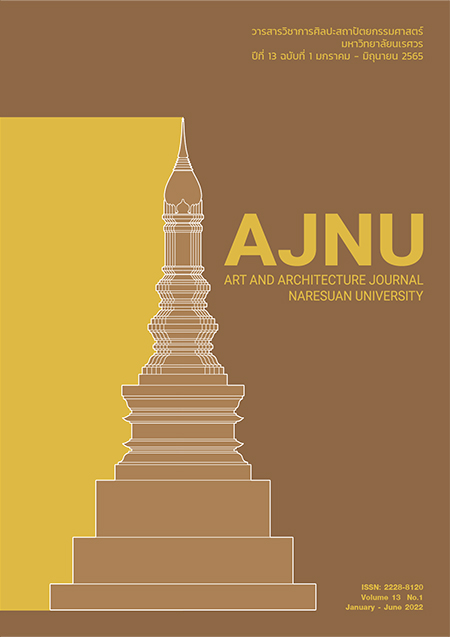Creative Research of Poetry Visual Arts. The series of “Sankhara the Manipulation of the Person's Insanity to the Creative of Poetry Visual Arts”
Main Article Content
Abstract
The creation of nowadays’ contemporary visual arts has been developed in different content formats, characteristics, and ideologies. There is, firstly, the idea which continuously develops and supports the value along with the principle of art in the mainstream. The next part is the anti-thinking toward. The past principle of aesthetic value of art which could be described as a mocking, sarcastic thinking, strongly stated as destroying. The last part is creating the new format by inspired applying and combining all those pros and cons of different kinds of art from all ages, including both past and present. These 3 ideas all mean to create the new innovative visual arts to distinct importantly from the original forms, contents, concepts, and styles. Creative Research of Poetry Visual Arts; The series of “Sankhara the Manipulation of the Person's Insanity to the Creative of Poetry Visual Arts” has all the according to the stated approaches. However, the creators have adopted 3 important criteria to classify the creation of this artwork into different types: art is the language of 1) Instrumentalism 2) Formalism 3) Expressivism. These are taken as the main principles and inspire to set the objectives for creating such ‘poetry visual arts. It consists of Researching and studying the creation of innovative visual arts by introducing two types of art processes and integrating them together, namely, visual arts; painting, drawing, and mixed media materials and the poetry part; poems. They are all fine art seeing that there is a concrete image that can be perceived by sense of sight. But what makes it special and different is that there is a language that communicates beauty out of this artwork series. The studying process of creating visual arts is a Creative Research Project of the R&D type. The creator has set a work plan in which focusing on studying the knowledge in two paradigms, namely, 1) the principles of Buddhism and 2) learning and understanding the principles of poetry visual arts creation which consists of visual arts and poetry. The essence of these two paradigms plays the role of enhancing and supporting until it appears as a creative process. This poetry visual arts were formed creatively with the clear process. It started from a feeling, an abstract form, improved and transformed into this concrete artwork series. In order to do that, the creator analyzed the artistic value and aesthetics of creative visual arts from visual elements; point, line, color, light, shadow and space, etc. brought together to form the language of beauty of visual arts. Then, the language, words and symbols which is the aesthetic language of poetry that convey artistic value or “Poetic flavor” of literary art was followed afterward. However, the perception to reach the aesthetic value of art of all types came to the mind, spirit which serves contemplation translating the essence and meaning of the name and art form to be able to recognize and understand the aesthetic value of art. To summarize the achievements of Creative research this poetry visual arts; the series of “Sankhara the manipulation of the person's insanity to the creation of poetry visual arts”, there are a total of 9 picture of the works, with creative strategies specifically the type of combine painting, including the use of ready-made mixed media materials including the cassettes which were accumulated for a large number by the creator when he was in the college. There are various international songs that the creators have a special personal preference for. They, the cassettes, become an important part of creativity by defining creative shapes with linear Painting mixed with painterly painting alternately. In the material composition in these visual art creations, there are correction pens, white crayons, chemical pens, oil pastels, oil paints, acrylic paints and oil paints on different sizes of canvas in a semi-abstract form that is self-contained. It is considered as a confirmation of the achievement of the objectives set completely and appropriately fit into unity both to the form, the content as well as the technique. So, it is a testament to the innovation of creating visual arts poetry that manifests their unique identity in a clear and concrete manner as well.
Article Details

This work is licensed under a Creative Commons Attribution-NonCommercial-NoDerivatives 4.0 International License.
References
กุสุมา รักษ์มณี. (2549). การวิเคราะห์วรรณคดีไทยตามหลักทฤษฎีวรรณคดีสันสกฤต. กรุงเทพมหานคร: โรงพิมพ์ธรรมสาร จำกัด.
ชลูด นิ่มเสมอ. (2531). องค์ประกอบศิลปะ. กรุงเทพมหานคร: ไทยวัฒนาพานิช.
พระพรหมคุณาภรณ์ (ป.อ. ปยุตฺโต). (2545). พจนานุกรมพุทธศาสตร์ ฉบับประมวลธรรม.กรุงเทพฯ:บริษัทสหมิกธรรมจำกัด
พระยาอนุมานราชธน. (2531). การศึกษาวรรณคดีในแง่วรรณศิลป์. กรุงเทพฯ: กรมศิลปากร.
พระราชวรมุนี(ป.อ. ปยุตฺโต). (2529). พุทธธรรม(พิมพ์ครั้งที่ 3). มหาจุฬาลงกรณราชวิทยาลัย.กรุงเทพฯ: บริษัทด่านสุทธาการพิมพ์จำกัด
ราชบัณฑิตยสถาน. (2525).พจนานุกรมฉบับบัณฑิตยสถาน.กรุงเทพฯ:อักษรเจริญทัศน์.
รอฮีม ปรามาส. (2548). อาณาจักรล่องหน (Invisible Word Exploring the Unseen ,Piers Bizony) แปลโดย รอฮีม ปรามาส, กรุงเทพฯ: สนพ.มติชน”
วิรุณ ตั้งเจริญ. (2544) . ทัศนศิลป์วิจัย. กรุงเทพมหานคร : โรงพิมพ์สันติสิริ.
สุรชาติ เกษประสิทธิ์. (2562). การสร้างสรรค์ทัศนศิลป์กวีทรรศน์; ชุดสังขารการปรุงแต่งประสบการณ์แห่งบุคคล (The
Creation of Visual Arts: Mental Formations (Sankhara), the Formed of an Individual Experience”).
พิษณุโลก: คณะสถาปัตยกรรมศาสตร์ มหาวิทยาลัย นเรศวร
อิทธิพล ตั้งโฉลก. (2550). แนวทางการสอนและสร้างสรรค์จิตรกรรมชั้นสูง.กรุงเทพมหานคร:บริษัทอมรินทร์พริ้นติ้งแอนด์
พับลิชชิ่งจำกัดมหาชน.
https://www.google.co.th/สัญลักษณ์แสดงสี+ฉัพพรรณรังสี
https://www.google.co.th/search?qทฤษฎีควอนตัม (Quantum Physics) &rlz


